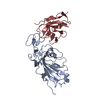+Search query
-Structure paper
| Title | Avidity engineering of human heavy-chain-only antibodies mitigates neutralization resistance of SARS-CoV-2 variants. |
|---|---|
| Journal, issue, pages | Front Immunol, Vol. 14, Page 1111385, Year 2023 |
| Publish date | Feb 21, 2023 |
 Authors Authors | Wenjuan Du / Rick Janssens / Anna Z Mykytyn / Wentao Li / Dubravka Drabek / Rien van Haperen / Marianthi Chatziandreou / Melanie Rissmann / Joline van der Lee / Melissa van Dortmondt / Itziar Serna Martin / Frank J M van Kuppeveld / Daniel L Hurdiss / Bart L Haagmans / Frank Grosveld / Berend-Jan Bosch /  |
| PubMed Abstract | Emerging SARS-CoV-2 variants have accrued mutations within the spike protein rendering most therapeutic monoclonal antibodies against COVID-19 ineffective. Hence there is an unmet need for broad- ...Emerging SARS-CoV-2 variants have accrued mutations within the spike protein rendering most therapeutic monoclonal antibodies against COVID-19 ineffective. Hence there is an unmet need for broad-spectrum mAb treatments for COVID-19 that are more resistant to antigenically drifted SARS-CoV-2 variants. Here we describe the design of a biparatopic heavy-chain-only antibody consisting of six antigen binding sites recognizing two distinct epitopes in the spike protein NTD and RBD. The hexavalent antibody showed potent neutralizing activity against SARS-CoV-2 and variants of concern, including the Omicron sub-lineages BA.1, BA.2, BA.4 and BA.5, whereas the parental components had lost Omicron neutralization potency. We demonstrate that the tethered design mitigates the substantial decrease in spike trimer affinity seen for escape mutations for the hexamer components. The hexavalent antibody protected against SARS-CoV-2 infection in a hamster model. This work provides a framework for designing therapeutic antibodies to overcome antibody neutralization escape of emerging SARS-CoV-2 variants. |
 External links External links |  Front Immunol / Front Immunol /  PubMed:36895554 / PubMed:36895554 /  PubMed Central PubMed Central |
| Methods | EM (single particle) |
| Resolution | 3.1 - 4.1 Å |
| Structure data |  EMDB-16480: Structure of the SARS-CoV-2 spike glycoprotein in complex with the 10D12 heavy-chain-only antibody (3 RBDs up)  EMDB-16481: Structure of the SARS-CoV-2 spike glycoprotein in complex with the 10D12 heavy-chain-only antibody (2 RBDs up) EMDB-16490, PDB-8c8p: |
| Source |
|
 Keywords Keywords |  VIRAL PROTEIN / VIRAL PROTEIN /  Complex / Spike / Complex / Spike /  Glycoprotein / Glycoprotein /  Antibody Antibody |
 Movie
Movie Controller
Controller Structure viewers
Structure viewers About Yorodumi Papers
About Yorodumi Papers







